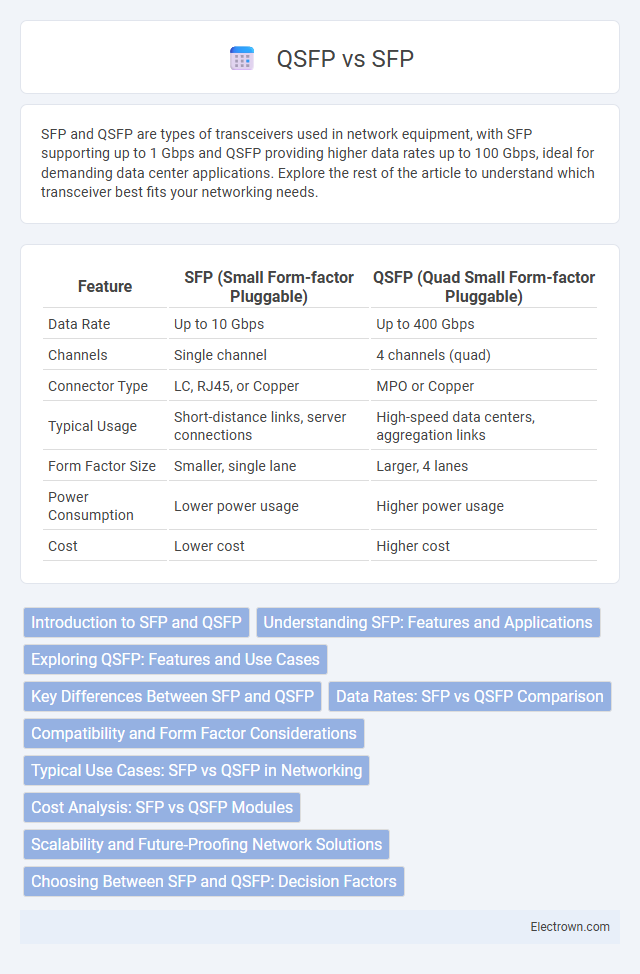SFP and QSFP are types of transceivers used in network equipment, with SFP supporting up to 1 Gbps and QSFP providing higher data rates up to 100 Gbps, ideal for demanding data center applications. Explore the rest of the article to understand which transceiver best fits your networking needs.
Table of Comparison
| Feature | SFP (Small Form-factor Pluggable) | QSFP (Quad Small Form-factor Pluggable) |
|---|---|---|
| Data Rate | Up to 10 Gbps | Up to 400 Gbps |
| Channels | Single channel | 4 channels (quad) |
| Connector Type | LC, RJ45, or Copper | MPO or Copper |
| Typical Usage | Short-distance links, server connections | High-speed data centers, aggregation links |
| Form Factor Size | Smaller, single lane | Larger, 4 lanes |
| Power Consumption | Lower power usage | Higher power usage |
| Cost | Lower cost | Higher cost |
Introduction to SFP and QSFP
SFP (Small Form-factor Pluggable) and QSFP (Quad Small Form-factor Pluggable) are vital transceiver modules in high-speed data communication networks, enabling efficient connectivity in switches, routers, and servers. SFP modules support data rates typically up to 10 Gbps, ideal for shorter distances and single-lane transmission, while QSFP modules handle higher bandwidths, often 40 Gbps or 100 Gbps, by aggregating multiple lanes. Your network performance and scalability depend on selecting the appropriate transceiver that matches the bandwidth demands and physical infrastructure.
Understanding SFP: Features and Applications
Small Form-factor Pluggable (SFP) modules are compact, hot-pluggable transceivers used primarily for Gigabit Ethernet and fiber channel applications, supporting data rates up to 4.25 Gbps. SFP modules offer flexible connectivity options for both short reach (multi-mode fiber) and long reach (single-mode fiber) networks, enabling seamless integration with various network switches, routers, and media converters. Their small size and versatility make SFP ideal for enterprise networks requiring scalable, cost-effective uplinks and fiber connectivity in data centers and telecommunication infrastructure.
Exploring QSFP: Features and Use Cases
QSFP (Quad Small Form-factor Pluggable) modules support higher data rates, typically up to 100 Gbps, making them ideal for data centers and high-performance computing networks where large bandwidth is essential. QSFP modules offer features like multi-rate support, efficient heat dissipation, and compatibility with various fiber types, enabling flexible deployments across short and long distances. Your network infrastructure can benefit from QSFP's scalability and high port density, which optimize space and facilitate aggregated connections for enhanced performance.
Key Differences Between SFP and QSFP
SFP (Small Form-factor Pluggable) modules support data rates typically up to 10 Gbps, while QSFP (Quad Small Form-factor Pluggable) modules handle higher bandwidths of 40 Gbps or 100 Gbps by aggregating multiple lanes. SFP transceivers are primarily used for single-channel connections in short to medium-range networking applications, whereas QSFP modules enable multi-channel, high-density networking crucial for data center and high-performance computing environments. The physical size and pin configuration differ significantly, with QSFP being larger and accommodating four times the channels compared to SFP, impacting port density and scalability.
Data Rates: SFP vs QSFP Comparison
SFP modules typically support data rates up to 10 Gbps, making them ideal for single-channel or short-distance applications. QSFP modules provide significantly higher data rates, supporting from 40 Gbps up to 400 Gbps by aggregating multiple channels, which suits data center and high-performance computing environments. Your choice depends on whether you prioritize lower data throughput with compact form factors or need ultra-high bandwidth for large-scale network infrastructure.
Compatibility and Form Factor Considerations
SFP (Small Form-factor Pluggable) modules support lower data rates, typically up to 10 Gbps, and feature a compact design ideal for 1G and 10G Ethernet connections, whereas QSFP (Quad Small Form-factor Pluggable) modules accommodate higher data rates, ranging from 40 Gbps to 400 Gbps, through aggregation of multiple lanes within a larger form factor. Compatibility challenges arise because SFP modules cannot be inserted into QSFP ports or vice versa, and each requires specific transceiver slots aligned with their form factor and electrical interface standards. Network infrastructure must carefully consider these form factor differences to ensure proper module-slot matching, support for desired speeds, and physical space constraints on switches and routers.
Typical Use Cases: SFP vs QSFP in Networking
SFP modules are typically used for connecting individual devices over shorter distances, such as within data center racks or for uplinking switches in enterprise networks, supporting speeds up to 10 Gbps. QSFP modules are designed for high-density, high-speed applications like data center core switches and aggregation layers, offering aggregated bandwidths from 40 Gbps to 400 Gbps. Your network deployment choice depends on required bandwidth, distance, and port density, where SFP suits lower-density, lower-speed needs, and QSFP handles high-performance, large-scale data transmission.
Cost Analysis: SFP vs QSFP Modules
SFP modules generally offer a lower initial cost compared to QSFP modules, making them a cost-effective choice for lower bandwidth requirements. QSFP modules provide higher port density and increased data rates, which can reduce overall infrastructure expenses in large-scale deployments by minimizing the number of required ports and cables. Evaluating your network's bandwidth needs and potential growth will help you determine the most cost-efficient option between SFP and QSFP modules.
Scalability and Future-Proofing Network Solutions
QSFP modules offer higher scalability compared to SFP by supporting greater data rates, typically up to 400 Gbps, enabling future-proofing of network infrastructure. SFP modules, while suitable for lower-speed links up to 10 Gbps, may limit expansion and upgrade options in rapidly evolving network environments. Investing in QSFP technology facilitates seamless integration of advanced, high-bandwidth applications, ensuring long-term network performance and flexibility.
Choosing Between SFP and QSFP: Decision Factors
Choosing between SFP and QSFP depends primarily on your network's bandwidth requirements and port density needs. SFP modules support speeds up to 10Gbps and are ideal for point-to-point links with lower data rates, while QSFP modules offer higher speeds up to 400Gbps, making them suitable for data centers requiring high-throughput and efficient cabling. Your decision should consider the existing infrastructure compatibility, future scalability, and budget constraints to optimize performance and cost-effectiveness.
SFP vs QSFP Infographic

 electrown.com
electrown.com